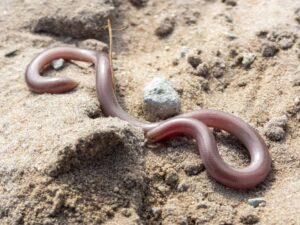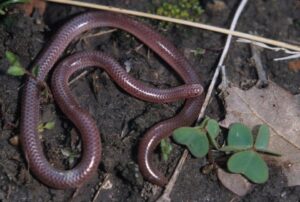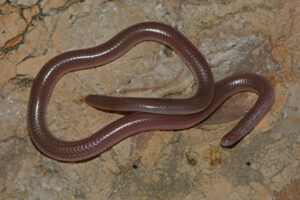The Texas blind snake is a native of the Southwestern United States and adjoining northern Mexico. The secretive, fossorial snake resembles a shiny earthworm in its looks. Despite its name, it is not entirely blind. It can see some light but mainly uses its sense of smell to track down its prey which leaves behind chemical trails. Its other common names are Texas slender blind snake and Texas threadsnake.
Scientific Classifications
- Suborder:Serpentes
- Family:Leptotyphlopidae
- Genus:Rena
- Species:R. dulcis
Conservation Status
Subspecies
The snake has three recognized subspecies.
- Rena dulcis dulcis
- Rena dulcis rubellum
- Rena dulcis supraorbicularis
Description
Size
The adults reach a length of 11 in (27 cm), including their tails.
Color and Appearance
The snake is pinkish-brown with very shiny scales. Its body doesn’t appear to have segments. Its eyes are just two dark dots under the head scales. A trait that makes it different from other snakes is that its upper jaws contain no teeth, and the lower jaw is very short, almost half the length of the skull. The top of the head has three scales in between the ocular scales.
Are They Dangerous to Humans
When handled, the snake generally squirms around and tries to poke the tip of its tail into the attacker. It is only a distractive measure and causes no harm. A foul odor can also be released from its anal glands if it feels threatened. Its mouth is too small to bite a human. A gentle and docile temperament has earned it favor with reptile pet enthusiasts.
Texas Blind Snakes at a Glance
Distribution
In the USA, the species occurs in western Oklahoma, including the panhandle, southwestern Kansas, southern and central Texas, and west through southern New Mexico to southeastern Arizona. In northern Mexico, it lives in Coahuila, Chihuahua, Tamaulipas, San Luis Potosí, Nuevo León, Veracruz, Hidalgo, Querétaro, and Puebla.
Habitat
It inhabits deserts, prairies, and, occasionally, people’s homes in its range.
It spends most of its time buried in loose soil, only emerging in the rains to feed when its habitat is flooded with water. It is often mistaken for an earthworm when it is spotted after the spring rains.
Lifespan
To date, its lifespan is unknown.
Predators
The Texas threadsnake has a long list of predators like night snakes, moles, domestic cats, and roadrunners.
Diet
It eats ants, termites, and their larvae.
When eating its food, it flexes its short lower jaw fast in a raking motion to fling its prey into its esophagus. It shares a commensal behavior with eastern screech owls that carry the live snake back to its nest to clean it of parasites.
Reproduction
Oviparous (lays eggs that hatch outside the body)
Mating occurs from late March to June when the male wraps itself around the female in a corkscrew shape in a crevice or under a rock. Eggs are laid in late summer. 1-6 eggs make up a clutch.
Source
sciencesource.com, a-z-animals.com, snakesarelong.blogspot.com, thehibbitts.net









